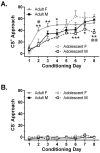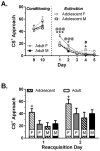Age and sex differences in reward behavior in adolescent and adult rats
- PMID: 23754712
- PMCID: PMC4782597
- DOI: 10.1002/dev.21127
Age and sex differences in reward behavior in adolescent and adult rats
Abstract
Compared to adults, adolescents are at heightened risk for drug abuse and dependence. One of the factors contributing to this vulnerability may be age-dependent differences in reward processing, with adolescents approaching reward through stimulus-directed, rather than goal-directed, processes. However, the empirical evidence for this in rodent models of adolescence, particularly those that investigate both sexes, is limited. To address this, male and female rats that were adolescents (P30) or adults (P98) at the start of the experiment were trained in a Pavlovian approach (PA) task and were subsequently tested for the effects of reward devaluation, extinction, and re-acquisition. We found significant interactions between age and sex: females had enhanced acquisition of PA and poorer extinction, relative to males, while adolescents and females were less sensitive to reward devaluation than male adults. These results suggest that females and adolescents exhibit reward behavior that is more stimulus-directed, rather than goal-directed.
Keywords: Pavlovian approach; adolescent; extinction; learning; rat; reacquisition; reward devaluation; reward processing; sex.
© 2013 Wiley Periodicals, Inc.
Figures




References
-
- Andrzejewski ME, Schochet TL, Feit EC, Harris R, McKee BL, Kelley AE. A comparison of adult and adolescent rat behavior in operant learning, extinction, and behavioral inhibition paradigms. Behavioral Neuroscience. 2011;125:93–105. doi:10.1037/a0022038. - PubMed
MeSH terms
Grants and funding
LinkOut - more resources
Full Text Sources
Other Literature Sources

